To date, pain in the knee joint is tormenting not only the elderly, but also young boys and girls. Indeed, age-related changes can lead to the occurrence of such a problem.
But it can also appear due to the lifting of heavy things, inactive lifestyle or difficult work, which implies a high load on knee-joint. Painful sensations in the knee interfere with normal life, as movements are limited.
To get rid of joint disease, it is worthwhile to be treated comprehensively. Various ointments can help eliminate the symptoms, alleviate the patient's condition. What tool to choose? What are the features of ointments for the knee joint?
Various factors can lead to the occurrence of knee joint disease. This may be affected by mechanical stress or by concomitant illness. When a person begins to feel pain in the knee, he needs to go to the doctor for a consultation. He will diagnose, diagnose, indicate the cause of the problem. All this must be taken into account in the future, when an ointment is selected.
You should not prescribe yourself a medicine. This must be entrusted to a specialist.
There are such types of drugs that doctors prescribe for diseases of the knee joint:
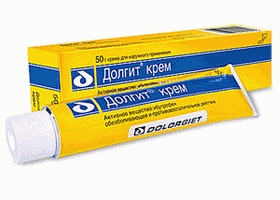
- Anti-inflammatory drugs intended for local exposure. This group of drugs is especially popular in the treatment of articular pathologies. These drugs act quickly, show a good effect. They are prescribed for any problems associated with the knee. To buy such a tool, a doctor's prescription is not required. Medicines are sold in all pharmacies.
- Ointments that have an irritating or warming effect. Often, natural components are used to produce them. Bee venom or red pepper are considered popular. With their help, there is a flow of blood to the affected area. As a result, restoration processes in the affected area are activated.
- Pain medication. They are prescribed to remove painful sensations that interfere with normal functioning.
- Chondroprotectors. The composition of such drugs concentrated the components necessary for cartilage health. Therefore, the use of drugs stimulates recovery cartilage.
- Homeopathic medicines. They represent a special group of drugs that are also used to treat joints.
What ointments are considered the most effective?
Quite often, doctors prescribe local remedies when they find joint diseases in patients. The use of ointments can improve the patient's condition. Basically, the doctor takes into account the characteristics of the disease, the causes of its occurrence, after which it is determined with which medicine to prescribe. There are many topical preparations. But some of them gained great popularity.
Chondroxide
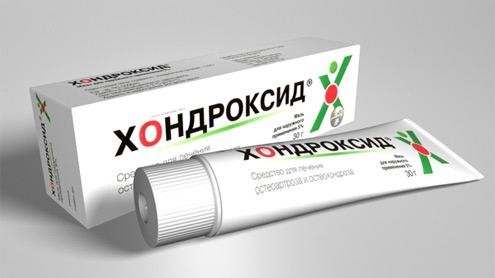 Chondroxide is often used for arthrosis of the knee joint. When a person applies the product to the affected area, you can observe the rapid absorption of the ointment, so the active substances penetrate the lesion site in a short period. The drug is part of the group of chondroprotectors. This medicine restores the joint and cartilage, slows down the development of pathology. It is especially useful to use the remedy for osteoarthritis and osteochondrosis.
Chondroxide is often used for arthrosis of the knee joint. When a person applies the product to the affected area, you can observe the rapid absorption of the ointment, so the active substances penetrate the lesion site in a short period. The drug is part of the group of chondroprotectors. This medicine restores the joint and cartilage, slows down the development of pathology. It is especially useful to use the remedy for osteoarthritis and osteochondrosis.
Using ointment, you can improve cartilage, reduce inflammation, which will positively affect the mobility of the joint. Also, the drug produces a slight analgesic effect.
The tool has a certain time of active exposure, which lasts 5 hours. Given this, experts advise repeating the application after a while. If there is damage in the affected area, then the ointment should be discarded.
Cream Dolgit
To date, such a tool is very popular. This is a non-steroidal drug that is intended for external use. The active substance is ibuprofen, whose concentration is five percent. Often, the cream is prescribed for arthrosis, neuritis, as well as for other injuries associated with the musculoskeletal system. When using the tool, do not forget about other medicines.
If you apply the cream to the damaged area, you can achieve this result:
- the inflammatory process will decrease;
- pain will decrease;
- edema will be eliminated, hematomas will disappear.
Thanks to the active component, the agent effectively reduces the inflammatory process, because ibuprofen provokes the blocking of inflammatory mediators. As a result, it stops and stops developing. When the cream is applied to the skin, it enters the synovial fluid. Withdrawal occurs with the help of the kidneys.
Apizartron
 The preparation contains bee venom. Ointment is an irritant that is intended for external use. Given this fact, Alizartron should be used with caution. Bee venom is the main active ingredient. The composition includes mustard oil, which helps to enhance the effect. When a person applies ointment to the skin, he will not feel a burning sensation, since the product has a gentle effect.
The preparation contains bee venom. Ointment is an irritant that is intended for external use. Given this fact, Alizartron should be used with caution. Bee venom is the main active ingredient. The composition includes mustard oil, which helps to enhance the effect. When a person applies ointment to the skin, he will not feel a burning sensation, since the product has a gentle effect.
After application, there is a vasodilation in the affected area, as well as an increase in skin temperature. As a result, tissues are better supplied with oxygen, and decomposition products are excreted. For the manufacture of the product, components are also used that reduce inflammation. Apizartron has a complex effect, relaxes muscles, reduces the inflammatory process, pain.

Capsicum
This drug is a warming ointment that has a local irritating effect.
When a person has applied the medicine to the affected area, the following processes occur:

- warming up the sore spot, improving blood circulation;
- decrease in pain;
- increased local immunity, as food becomes better;
- reduction of the inflammatory process.
To notice the result, you should wait about 30 minutes. The effect of the drug persists for 6 hours.
Such a remedy is often prescribed for radiculitis, osteochondrosis, arthritis, as well as painful muscles. Often, athletes use ointment to warm up the muscles.
Horsepower
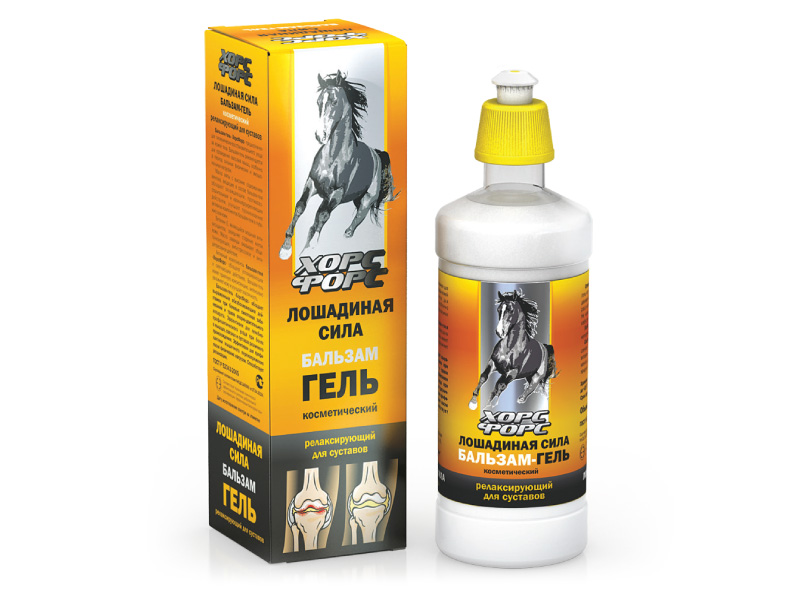 The gel called Horsepower gained great popularity. Doctors often prescribe it when patients are diagnosed with arthrosis and osteochondrosis. It will also help with damage to ligaments and joints. Often after strong physical activity, a person is faced with overstrain. Horsepower Gel helps eliminate unpleasant symptoms.
The gel called Horsepower gained great popularity. Doctors often prescribe it when patients are diagnosed with arthrosis and osteochondrosis. It will also help with damage to ligaments and joints. Often after strong physical activity, a person is faced with overstrain. Horsepower Gel helps eliminate unpleasant symptoms.
Means for a short period reduces pain. This is due to the active ingredients of natural origin. The composition of the drug included lavender oil, peppermint and vitamin E. The tool will not help get rid of joint diseases, but it will remove unpleasant symptoms.
To get a good result, you should apply the product and rub it into the skin until it is absorbed. If there are injuries or wounds in the affected area, then the use of the drug should be postponed. After the cream has been applied, it is recommended to wrap your leg for an hour, during which time it is better to stay at rest.
Diclofenac
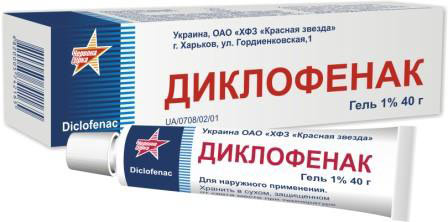 Such a medicine is often used for joint diseases. It has a low price, it can be bought at every pharmacy. Diclofenac is part of the group of drugs against inflammation.
Such a medicine is often used for joint diseases. It has a low price, it can be bought at every pharmacy. Diclofenac is part of the group of drugs against inflammation.
It is prescribed in such cases:
- with the development of arthritis, degenerative changes in the joints;
- with the inflammatory process;
- if neurological pain has appeared;
- when mechanical damage to the knee joint occurred.
The application should be repeated a couple of times a day. It is smeared at the place where the inflammation appeared. A maximum of 8 g of medication is allowed per day. The application procedure is carried out every day. You can be treated in this way for no more than 2 weeks.
ethnoscience
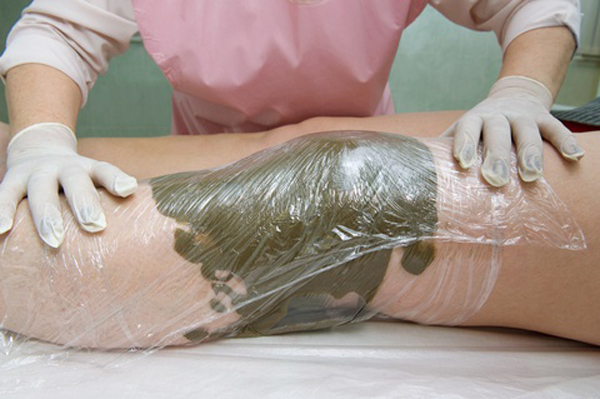 It is not always possible to visit a pharmacy at a particular moment. In this case, you can use folk remedies. They will also be a great addition to the main treatment. For the preparation of folk ointments, only natural ingredients are used. To get the desired result, you should stick to the recipe.
It is not always possible to visit a pharmacy at a particular moment. In this case, you can use folk remedies. They will also be a great addition to the main treatment. For the preparation of folk ointments, only natural ingredients are used. To get the desired result, you should stick to the recipe.
Despite the natural origin of such drugs, it is recommended that you consult a doctor initially. In addition, do not forget about the main treatment, because some folk remedies will not help solve the problem.
Here are some recipes for ointments that people often use for diseases of the knee joint:
- The use of turnips. To do this, you need to get an unspoiled good turnip. It is cleaned and crushed to make slurry. Then it combines with 20 g of vodka and 100 g of honey. In carefully mixed form, ointment lubricates sore spots. You need to do this several times a day.
- The use of eggs and vinegar. To make the medicine, you need to put the unpeeled egg in a glass vessel. Next, vinegar essence is poured into the container, the egg should be completely covered. All this moves to a dark place for 5 days. During this period, the complete dissolution of the shell will occur. Next, a glass of sunflower oil is poured into the resulting mixture. Now the vessel is placed in a sunny place. He should be there again 5 days. After the time has passed, you can start using it. The resulting ointment is rubbed into sore spots. After application, the joint wraps up.
- If it is difficult for a person to bend or unbend a limb in the knee, he feels pain, then it is worth preparing a special folk ointment. To do this, take in the same amount of iodine, honey, alcohol, as well as glycerin. All this is mixed, infused for a couple of hours and rubbed into the skin in the affected area.
If you do not treat the knee, the condition will worsen. You may end up with disability.
Draw conclusions
Have you ever tried to get rid of joint pain yourself? Judging by the fact that you are reading this article, the victory was not on your side. And of course you know firsthand what it is:
- Joint pain that limits your movement and full life ..
- Discomfort, crunch and systematic pain ..
- Swelling and redness around the affected joint ..
And now answer the question: DOES THIS SOLVE YOU? Aren't you tired of putting up with it? And how much money have you "poured" into ineffective drugs? That's right - it's time to heal the joints once and for all! Do you agree?
“Remember the simple truth, and don’t listen to anyone: the joints are always treatable, even in the very ripe old age”
The great ancient Greek scientist and philosopher Aristotle said: "Movement is life." But, unfortunately, not all people can fully enjoy it. Every tenth person on the planet experiences pain after physical activity, crunching in joints and internal stiffness of movements, which significantly worsens the quality of life. So the first signs of arthrosis are manifested. The article discusses when it is necessary to give injections to the knee joint with arthrosis, drugs necessary for these procedures.
What is arthrosis and causes
Arthrosis is a chronic disease that manifests itself in the gradual destruction of intraarticular cartilage. As a rule, the disease manifests itself in elderly people as a result of the natural process of aging of body tissues, but recently, men and women older than forty years are increasingly diagnosed with this disease. 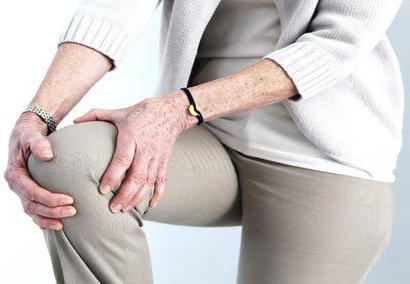
This is due to the fact that the physical activity of the population has significantly decreased: sedentary work, the use of public transport and personal cars, unbalanced plentiful food - as a result, overweight, which increases the load on the joints. As a treatment, doctors offer injections to the knee joint. With arthrosis, drugs are injected mainly into the joint.
The causes of secondary arthrosis can be traumatic lesions (bruises, dislocations, fractures), too high loads for athletes and workers, whose field of activity is associated with heavy physical labor. In addition, other factors can create prerequisites for the development of the disease, such as autoimmune diseases, previous infectious and inflammatory processes, genetic predisposition, diseases of the endocrine system, metabolic disorders and others.
How cartilage is destroyed
All joints in the human body have an almost identical structure - two or more articular surfaces lined with cartilaginous tissue enclosed in a synovial bag containing synovial fluid. Hyaline cartilage has a smooth and elastic structure, which reduces friction during movement. Joint nutrition is carried out through synovial fluid, since it does not have its own blood vessels. 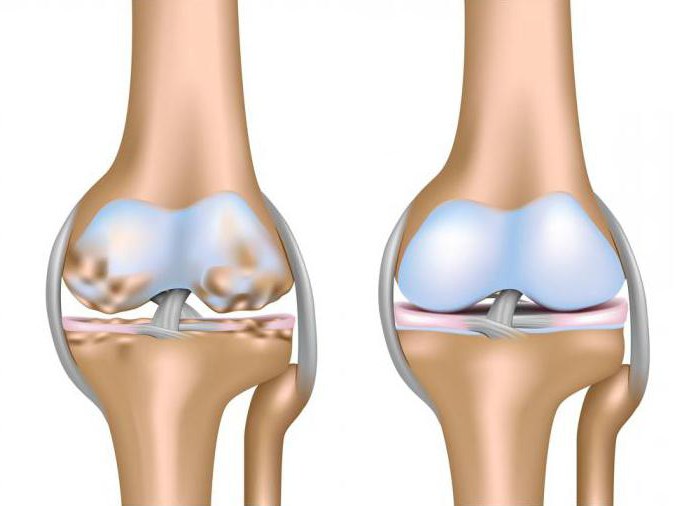
It is this property that makes cartilage vulnerable. Due to a malfunction in metabolic processes or an excessively large articular load, hyaline cartilage can undergo degenerative changes, and in the absence or inadequate nutritional supply, its restoration and regeneration is extremely slow. Thinning of the layer of hyaline cartilage leads to increased friction in the joint during movements, which leads to accelerated destruction of the cartilage and contributes to the development of inflammatory processes. In humans, this process is manifested by the occurrence of pain, stiffness, and limitation of mobility. At this stage, injections to the knee joint may come to the rescue. Reviews of specialists and patients about these procedures indicate their effectiveness.
At the final step of this pathological process, the cartilage is destroyed, and instead of it, coarse connective tissue grows. As a result of such changes, the joint is deformed and can no longer perform its functions. To prevent this from happening, chondroprotectors are used. The price of them is low and allows you to apply them quite widely.
Unfortunately, they act only at the initial stages of cartilage tissue destruction and may not produce the expected effect in the case of a running process. In addition, it is necessary to take such drugs for a long time, for three to six months, and in some individual cases up to one and a half years, because cartilage tissue regenerates extremely slowly. The duration of the course, the mode of administration, which injections into the knee joint and in what dosages to produce, all this is determined and prescribed by the doctor individually for each patient, based on the initial condition and observing the changes during treatment.
Ways and methods of treatment
Treatment of arthrosis can be medication and surgical. Surgical treatment implies a joint replacement - endoprosthetics. 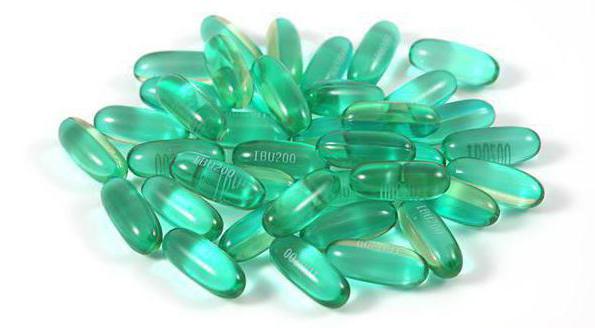
The main task of drug therapy for arthrosis is to stop further destruction of cartilage tissue and preserve joint function.
For treatment to give good results, it should be aimed at removing inflammatory processes, pain and restoration of cartilage. To do this, use:
- anti-inflammatory non-steroidal agents;
- intraarticular drug injections;
- local warming agents to improve blood flow in the affected area (in the form of ointments, gels and creams);
- chondroprotectors.
Non-steroidal anti-inflammatory drugs
Medicines of this type relieve inflammation, swelling, have an antipyretic and analgesic effect. 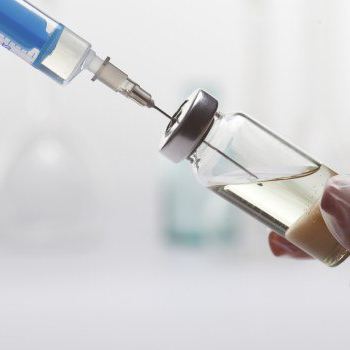
According to the severity of the analgesic effect, the most powerful are: "Ibuprofen", "Diclofenac sodium" ("Voltaren"). NSAIDs do not cause euphoria, drowsiness, addiction, drug dependence, but their prolonged use is detrimental to the gastric mucosa. Therefore, for the relief of acute pain, Diclofenac (injections) is prescribed. The price of five ampoules in a package is about two hundred rubles. Application: intramuscularly for two to five days, and then transferred to the tablet form of the drug (if necessary).
It is also possible to use "Ketonal" - injections intramuscularly or intravenously, as well as injection forms of "Flamax", "Arthrosilene". With intravenous administration, the intervals between procedures should be at least 8 hours.
Hormonal corticosteroids and chondroprotectors
The price becomes not so important if the pain overcomes, and ointments or creams are no longer effective. When arthrosis reaches the stage of exacerbation, it becomes advisable to take hormonal corticosteroids. These drugs contribute to the rapid and effective suppression of the inflammatory process, but with prolonged use lead to the destruction of the joint and often cause adverse reactions. 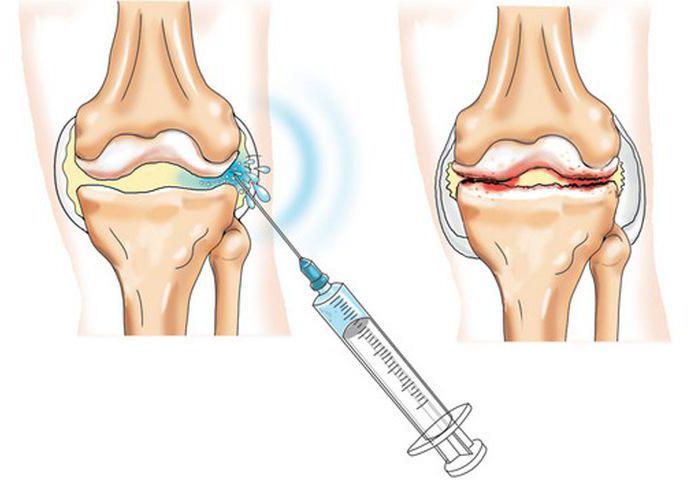
Therefore, doctors prescribe from the corticosteroids intraarticular preparations “Diprospan”, “Kenalog”, “Hydrocortisone” in the form of injections, which reduces the likelihood that undesirable consequences will occur to a minimum.
Chondroprotectors are drugs and drugs that contribute to the formation of completely new structural elements of cartilage tissue. They regenerate it and prevent further destruction.
Chondroprotectors include two key components: glucosamine and chondroitin sulfate. It is these substances that are required for the formation of synovial fluid, and the human body normally produces them themselves.
Release Forms
Currently, pharmaceutical companies produce chondroitin and glucosamine in the following forms:
- solutions for injection;
- capsules, oral powders, tablets.
Three generations of chondroprotectors are distinguished:
- First - animal origin. Usually well tolerated, the effect occurs quickly, but can lead to allergies. This type includes drugs such as Rumalon and Alflutop.
- Second - synthetic preparations of chondroitin sulfate (“Chondroxide”, “Structum”, “Chondrolon”, “Mukosat”), glucosamine (“Don”, “Elbon”, “Sustilak”) and hyaluronic acid (“Fermatron”, “Synvisc”, “ Hyaluron "," Gialgan ")
- Third - complex (combined) medicinal substances that contain various combinations of chondroitin and glucosamine ("Arthra", "Teraflex").
Classification by route of administration
The classification of chondroprotectors is based on various methods of administration:
- Intraarticular injection - The most effective method, since the effect develops quickly and lasts long enough. To repeat such manipulations is necessary only a few times a year. It is suitable for preparations that contain hyaluronic acid, such as Gialgan, Fermatron. The disadvantages of this method include the fact that injections into the joints are medical manipulation and are carried out in a hospital. Most often, the introduction of chondroprotectors is carried out in the knee joints.
- Intramuscular injection - A convenient and widespread method of administering chondroprotectors. In this way, Alflutop, Chondrolon, Artradol, Chondrogard and many other intramuscular preparations are administered. Suitable for patients who, for various reasons, are unable to swallow a tablet or capsule or have severe kidney disease.
- Capsules and pills - the most used and widespread method of drug administration. It does not require aseptic conditions, the intervention of specially trained personnel, suitable for independent use. However, this method also has drawbacks: a long course of treatment, a large drug load on the liver and kidneys.
- External use in the form of creams, ointments or gels, - the method is good as an adjunct to the oral route of administration, but not as monotherapy. Hyaluronic acid and chondroitin preparations practically do not penetrate the skin into the joint, but in combination with physiotherapeutic methods, the permeability of these substances can increase. As an anesthetic, you can use Diclofenac "(injections). The price of external preparations is in the range of 200-600 rubles.
The most effective drugs
The most effective remedy is Alflutop (S.C. Biotehnos, S.A; Romania). The basis of the drug is the extraction of four species from marine organisms. The low-fat concentrate is free from impurities and proteins. The main effect of the drug is aimed at regulating metabolic processes in the tissues of the cartilage. 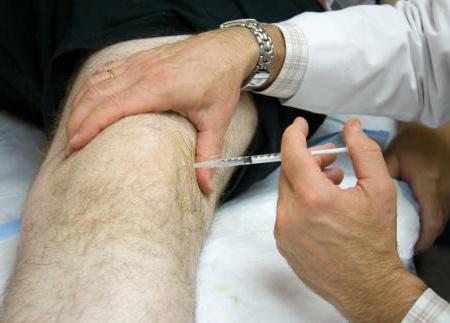
Similar effects are possessed by such drugs as Chondroxide, Chondrolone, Structum, Don. Application: intramuscularly, deeply, 1 ml daily for three weeks.
With the participation in the process large joints the introduction is carried out intraarticularly one or two milliliters into each diseased joint once every three to four days (the total number is five to six injections), and then intramuscular injections, which are carried out for twenty days. Repetition of the course should be done in six months.
Funds can be delivered in packages of ten one-millimeter ampoules or five ampoules of two ml each.
The approximate price in pharmacies is 3300 rubles per package.
The drug "Rumalon"
One more effective drug recognized by Rumalon (CJSC Bryntsalov A, Russia). It includes an extract of the brain and cartilage of the calf trachea.
Application: only for deep For adults, the dose is 1 ml three times a week or 2 ml twice a week. The positive effects of such therapy become noticeable after a couple of weeks of treatment. The full course of treatment includes 25 injections of 1 ml each or 15, but 2 ml (for 6-8 weeks). Injection courses should be repeated twice a year at least or up to four times a year with a complicated course of the disease over several years.
Available in packs of ten ampoules containing one milliliter of the finished solution.
The approximate price in pharmacies is from 1100 rubles per package.
Drugs with glucosamine and chondroitin
Classical and widely used are such means:
- "Don" - glucosamine preparation, is a powder for oral administration and a ready-made solution in ampoules for injection. It is made by the Italian company Rottapharm. The price of packaging is from 900 to 1600 rubles.
- "Artradol" - a chondroitin preparation for intramuscular administration of the production of the Russian company Trivium. The package can be 10 or 5 ampoules of 2 ml. The price is about 700-1000 rubles per package.
- Chondrolone - a solution of chondroitin sulfate in ampoules of Russian production. One package priced from 1000 to 1300 rubles contains ten ampoules.
- Structum - The preparation of chondroitin sulfate in capsules is produced by the French company Pierre Fabre Medicament Production. Available in two dosages - 500 and 250 mg. The price in pharmacies is approximately 700 - 1500 rubles per package.
Combinations of chondroitin and glucosamine
Combined medications:
- Arthra - tablets. Are made by the American company UNIPHARM. Contain a dosage of 500 mg and chondroitin sodium sulfate 500 mg, practically have no side effects. Release form - tableted, 30-120 pcs. in the package, the price varies from 500 to 1900 rubles, depending on their quantity.
- Teraflex - a complex preparation of the American company Sagmel, contains chondroitin 400 mg and glucosamine 500 mg, is available in cream and capsule form. One package contains 30-120 capsules, the price, depending on the number of capsules, is 550-1850 rubles.
- There is also an enhanced formula of the drug - Teraflex Advance. It differs from the classical one by the presence of ibuprofen in the composition of a non-steroidal anti-inflammatory drug. Together with oral administration of capsules, it is recommended to use chondroitin and glucosamine preparations externally (“Teraflex” in the form of a cream).
Injections into the knee joint for arthrosis: hyaluronic acid preparations
The most common hyaluronic acid preparations in pharmacies are currently:
- “Ostenil”, “Sinokrom” and “Sinokrom Forte” - from Austria and Germany, “Fermatron” - from the UK, “Suplazin” - from Ireland.
- Not so often, but still there are such drugs as “Viscosil” (Germany) and “ViscoPlus” (Sweden), Italian “Gialgan”, “Giallux” (South Korea), American “Synvisc” and “Duralan Es Jay”.
- Of the drugs produced in Russia, Intraject Gialoform (Tuscany Moscow) and Giastat (Tula) are distinguished.
Preparations of hyaluronic acid for injection into the joint are produced ready-made in disposable syringes, which is very convenient for use.
Intra-articular injections in the knee joint with arthrosis, hyaluronate-based drugs affect the diseased organ in three directions:
- reduce friction and increase amortization due to the fact that they increase the amount of synovial fluid and its viscosity;
- intensively nourish the cells of cartilage tissue, thus stimulating the regeneration of hyaline cartilage;
- prevent inflammatory processes and reduce the severity of their manifestations.
Conclusion
It can be stated that the knee joint is a modern tool for the treatment of diseases associated with the musculoskeletal system. In the initial stages, the drug has a striking effect and allows you to forget about the manifestations of arthrosis for a long time. This safe fluid implant significantly reduces the load on the joint, supplies the cartilage with nutrients and forms a natural prosthesis, which is very similar in composition to human synovial fluid.
Also effective are drugs containing chondroitin and glucosamine.
Intra-articular administration of these drugs has a quick and lasting effect.
The fastest and most convenient way to get rid of severe pain with arthrosis is an injection. The procedure itself, if it is carried out correctly, is painless, but if it comes to the knee joint, then unpleasant feelings just go through the roof.
Despite this, many people who suffer from excruciating attacks of pain in the knee joint are prepared to endure these injections. Below we consider when injections into the knee are appropriate, how they are performed, and what drugs they are administered.
Indications for injections in the knee joint with arthrosis
The importance of the knee joint is difficult to overestimate. Its mobility enables people to perform many movements that many people have on the machine. People begin to feel the joint only when an inflammatory process appears in the knee. Shackling and severe pain, makes even ordinary movements simply impossible, which significantly interferes with living everyday life, and feelings of pain also torment morally.
Joint diseases that provoke a significant pain syndrome and are removed with the help of injections of blockers are as follows:
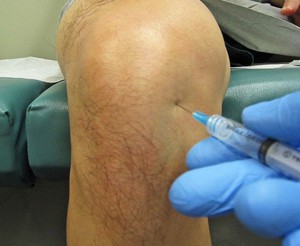
As a rule, these diseases accompany elderly people who are characterized by wear and tear of the joint, against which the inflammatory process and swelling appear.
The effectiveness of injections into the knee joint is very high, since the drug passes to the very site of pain, instantly removing the acute symptoms. Taking the same drugs orally, intravenously or intramuscularly, the activation rate of the drug and its effectiveness is significantly reduced.
Also, injections have other advantages:
- increase joint mobility;
- strengthen periarticular muscles;
- remove swelling and swelling of muscle fibers;
- stimulate the joint;
- improve blood microcirculation in the joint muscle of the joint.
Types of injections
Not all drugs can remove pain in the knee joint with arthrosis. There are three types of drugs that can relieve severe pain and relieve the condition of the knee joint:
- Chondroprotectors - organize proper nutrition of the cartilage, activating and normalizing its performance;
- Hyaluronic acid - best suited if there is a lack of synovial fluid in the joint that is responsible for knee mobility;
- Corticosteroids - instantly relieve pain, but do not remove its cause.
We will analyze in more detail all categories of injections with a detailed description of medications.
Corticosteroid injections in the joint
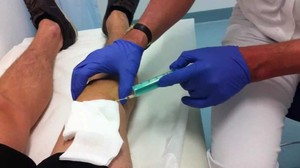 Corticosteroids are the fastest way to help the knee joint with arthrosis. In seconds they help reduce swelling and remove pain. But their use does not imply full healing, since their main task is to remove pain. The drugs of this group are perfectly combined with other medicines that are used in the complex treatment of arthrosis and arthritis.
Corticosteroids are the fastest way to help the knee joint with arthrosis. In seconds they help reduce swelling and remove pain. But their use does not imply full healing, since their main task is to remove pain. The drugs of this group are perfectly combined with other medicines that are used in the complex treatment of arthrosis and arthritis.
Of the most commonly available and effective corticosteroids, the following drugs can be noted:
- Phlosterone - used for frequent bouts of pain, but has many side effects;
- Loracort - is used no more often than several times a month, since the drug has a great effect on the vascular and nervous systems;
- Hydrocortisone - stops neural sensitivity, and this helps to remove pain;
- Diprospan - has many contraindications (trophic tissue changes, peptic ulcer, diabetes mellitus), because it is usually replaced with Betaspan;
- Ketorolac - an analogue of Ketanov instantly removes discomfort and pain, but negatively affects the cardiovascular system.
Despite the fact that corticosteroids are indispensable, their use must have clear limitations. There are a number of side effects that can aggravate the passage of arthritis.
These effects include:
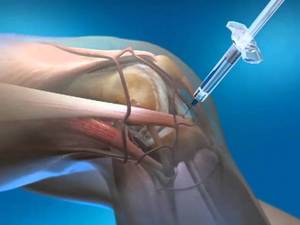
I.e, corticosteroids should be used only at the initial stage of treatment diseases of the knee joint with arthrosis, combining injections with other therapeutic treatment options.
Hyaluronic Acid Injection
These injections with a natural preparation make it possible to produce full knee joint treatment. The fluid that is injected covers the areas of bone contact with a film that facilitates motor activity, and anesthetizes it.
Hyaluronic acid injections have many advantages:
- maintaining water balance in the joint;
- protection of cartilage from deformation by bone tissue;
- plasticizing cartilage;
- feeding cartilage tissue with all the necessary trace elements.
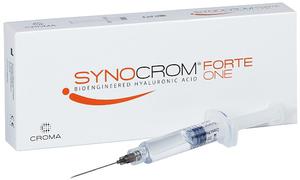 Since the drug is natural, it has almost no adverse reactions and contraindications. This fact allows apply hyaluronic acid in treatment for quite a long time, not worrying about the consequences. The only drawback is its rather expensive cost.
Since the drug is natural, it has almost no adverse reactions and contraindications. This fact allows apply hyaluronic acid in treatment for quite a long time, not worrying about the consequences. The only drawback is its rather expensive cost.
The most popular drugs that contain hyaluronic acid are:
- Sinocrom - indispensable during the prophylactic treatment of inflammatory chronic processes of the joint;
- Hyalux - the drug can create side effects in the form of rashes on the skin, but its affordable cost and effectiveness smooth out this disadvantage;
- Ostenil - is the most affordable drug, but is not used in the presence of chronic diseases of the kidneys and liver, as well as severe mental disorders;
- Viscosil - is not used for advanced stages of arthrosis and arthritis, since its effectiveness is observed only in acute stages;
- Fermatron Plus - an expensive drug made in England, helps in treatment, and also has an analgesic effect.
These preparations contain only some of the active substance, because their cost is more affordable than pure hyaluronic acid.
Chondroprotectors
They are based on a natural element - chondroitin, which is directly involved in the formation of cartilage. Wherein injection solution has glucosamine, without it, the first element is not fully absorbed.
Preparations of this group with arthrosis have many advantages:
- cartilage tissue strengthening;
- activation of the natural regeneration process;
- cartilage tissue nutrition.
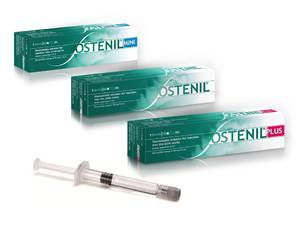 Chondroprotectors give results only if inflammation and swelling are removed. Injection Course from 4 to 17 injections, this is enough to normalize the knee joint. They are not used in the third stage of knee diseases, since it is easier to implant completely damaged and depleted cartilage than to restore it with injections.
Chondroprotectors give results only if inflammation and swelling are removed. Injection Course from 4 to 17 injections, this is enough to normalize the knee joint. They are not used in the third stage of knee diseases, since it is easier to implant completely damaged and depleted cartilage than to restore it with injections.
- Alflutop - quickly restores cartilage nutrition, but prolonged use sometimes causes side effects;
- Teraflex Plus is a rather expensive drug, but has the maximum result;
- Chondrolone - do not use during infectious infections of the skin;
- Don - a foreign medicine that has no analogues, makes it possible in a short time to normalize the production of synovial fluid and restore cartilage nutrition;
- Elbona - fights with friability of the cartilage tissue of the joint, and also has a comprehensive anti-inflammatory effect.
Since chondroprotectors are made on the basis of animal and plant extracts, their price, just like that of hyaluronic acid, is quite high.
Which injections are better to choose?
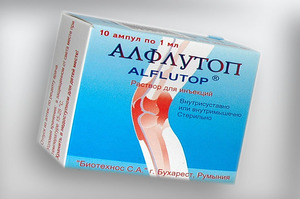 It must be understood that drugs of different groups have different effects on the joint, because their use is appropriate only in exceptional cases. It should be noted that injections of chondroprotectors and hyaluronic acid are used only if if the phase has passed pain syndrome
which corticosteroid drugs do well. It makes no sense to give an expensive injection if the process of inflammation in the active phase occurs with high swelling, as there is a risk of infection near the tissues and cartilage during its puncture with a syringe.
It must be understood that drugs of different groups have different effects on the joint, because their use is appropriate only in exceptional cases. It should be noted that injections of chondroprotectors and hyaluronic acid are used only if if the phase has passed pain syndrome
which corticosteroid drugs do well. It makes no sense to give an expensive injection if the process of inflammation in the active phase occurs with high swelling, as there is a risk of infection near the tissues and cartilage during its puncture with a syringe.
Among corticosteroids the most the best drugs are hydrocortisone and prednisone. They remove pain in the shortest possible time, making it possible switch to complex treatment of the knee joint. Corticosteroids are not used for prolonged use, therefore, these injections should be resorted to only in the most critical situations.
In its pure form, hyaluronic acid has an incredible ability to restore the knee joint in a short time. But the high price makes the treatment process inaccessible to many people, forcing them to choose cheaper analogues of drugs based on this acid.
Chondroprotectors are also used in certain cases, if treatment for arthrosis involves restoration of cartilage tissue. The most effective are injections of Alflutop and Chondrolone.
Contraindications
It is forbidden to use injections for arthrosis if a person has such indicators:
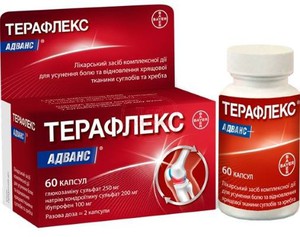
If the injections do not give the desired effect (all the more, this applies to the neglected stages of arthrosis), they must be canceled by choosing more radical methods of treatment.
Rules for injections:
- The doctor must make sure that there are no contraindications in the treatment of arthrosis.
- Before treatment, a test is made, due to which the absence or presence of an allergy to the medicine is determined.
- Injections are made only by an experienced doctor who is convinced of his abilities and as a solution for injection.
These three main points make it possible to get maximum results from injections.
To achieve a good effect, injections of chondroprotectors and hyaluronic acid are carried out in a course of 11–25 injections. This is enough for the body to start the natural processes of regeneration.
How is the procedure?
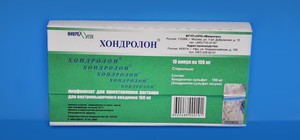 The doctor in a syringe collects a suspension of active substances and makes an injection into the gap of the knee joint. For convenience, a person is offered to bend his leg a little in the knee. it facilitates the procedure for getting the needle into the desired placeand also reduces the risk of injury. The dose and depth of puncture of the drug is chosen individually, taking into account the severity of the disease and the age of the patient.
The doctor in a syringe collects a suspension of active substances and makes an injection into the gap of the knee joint. For convenience, a person is offered to bend his leg a little in the knee. it facilitates the procedure for getting the needle into the desired placeand also reduces the risk of injury. The dose and depth of puncture of the drug is chosen individually, taking into account the severity of the disease and the age of the patient.
An injection is rather painful only if a severe inflammation is taking place. In order to avoid impulsive movements of the limb, as well as intensifying pain, local anesthesia is sometimes used. Also, pain depends directly on the composition and quality of the drug, as well as on the presence of chronic diseases and the severity of the disease.
Before the injection, the doctor pumps out the gathered fluid from the joint and gives it to the laboratory for analysis. Only after this, you can perform an injection into the knee joint, having previously treated with alcohol the skin puncture site.
If the joint is modified, then the introduction of the needle can be carried out, controlling with an ultrasound machine. He will be able to help more accurately identify the location of the gap in the joint, which makes it possible to protect a person from unnecessary punctures.
Price of treatment
Corticosteroids are the cheapest of intraarticular injections. Their price is not more than 35-40 rubles. for one ampoule.
In its pure form, hyaluronic acid costs about 4,500 rubles. for one injection. A full course requires at least 16 injections. Cheaper analogues, which have only a small part of hyaluronic acid, will cost about 400-900 rubles. per ampoule.
Chondroprotectors, especially those of animal origin, are also quite expensive from 1700 rubles. for one injection. The course requires about 24 injections.
So, intraarticular injections are considered the most effective and best option for combating arthrosis and other diseases of the knee joint. But the high cost of many drugs makes injections almost inaccessible to many patients. Despite this, the course of treatment can be chosen so that its cost is affordable. Why choose cheaper drugs analogues that perform the same functions.
Important! Doctors in shock: "An effective and affordable remedy for joint pain exists ..." ...
Osteoarthritis of the knee is a disease that affects the joint bag and provokes its destruction through the development of an inflammatory process in it.
Degenerative-dystrophic processes occur in the articular cavity, which are the result of partial or total destruction of the cartilage tissue of the joint.
There are many ways to treat this disease. Injections into the joint with arthrosis are introduced to restore the knee's efficiency and prevent the inflammatory process. Such treatment is quite expensive and not every patient can afford it.
Various drugs can be injected into the joint. There are different types of such injections.The doctor selects a specific medication for each patient, depending on what result the patient wants to achieve and how much the disease has started. This treatment is much more effective than conventional medication or standard injections into muscle tissue. Injections into the joint are injected directly into the site of inflammation. This prevents the medicine from losing its properties and the effect is really strong. Such injections have no side effects, which makes their use even more attractive.
Initially, injections were injected into the joint bag just to save the patient from pain. But later drugs appeared that were able to act directly on the inflammation itself and neutralize the destructive processes in the knee. They began to be used to restore the functioning of articular cartilage.
Corticosteroids for joint treatment
Some injections are prescribed to a patient with arthrosis not for a long course of treatment, but for isolated cases of the removal of severe pain syndromes or other symptoms. Such drugs are injected into the joint, and their main task is to improve the patient's condition during exacerbation.
It is important to understand that when a joint syndrome appears, accompanied by redness, pain and a local increase in temperature, in no case can you do an injection of glucocorticoids, a full course of diagnostic measures is required to establish a diagnosis. If glucocorticoids are injected into a joint in which there are no destructive or degenerative-dystrophic changes, the cartilage tissue and periarticular tissues begin to be destroyed due to the pathological action of hormones. A corticosteroid has a therapeutic effect only in case of changes in the joint, therefore it cannot be used for prophylaxis or without need.
In many cases, such injections are prescribed too often, which can lead to negative consequences. Corticosteroid drugs include glucocorticoid and mineralocorticoid hormones. Drugs of both 1 and 2 categories affect the main symptoms of arthrosis. Their main task is to eliminate pain and swelling. True, glucocorticoid hormones have a broader spectrum of actions compared to mineralocorticoid hormones. These drugs allow you to achieve a very quick effect and prepare the way for further treatment.
Quite often, you may encounter a situation where mineralocorticoid drugs are prescribed in more quantity than they should. In this case, when symptoms stop before the end of the course, the patient should inform the doctor. Such medications should not be injected into the joint as a preventive element. Their function is to specifically eliminate the symptoms of the disease.
Mineralocorticoid hormones, unlike glucocorticoid drugs of the corticosteroid group, cannot prevent the development of arthrosis or directly affect the focus of the disease. They are not able to restore the full or partial functioning of the joint. That is why the dosage of such drugs should be accurately prescribed by a doctor. It is forbidden to use such medications on your own.
Glucocorticoid treatment
With arthrosis, quite often the patient is prescribed treatment with special injections - glucocorticoids. These drugs are able to quickly relieve the patient of all the obvious symptoms of the disease, stop the destructive process and save the joint.
They are used for arthrosis in cases of treatment failure with the help of non-steroidal anti-inflammatory drugs. They have a sharp, quick healing effect and slow down the appearance of new erosion and destruction in the bone and cartilage. Slowing down the morphological changes in the articular surfaces under the influence of glucocorticoids and symptomatic improvement (that is, a decrease and complete absence of pain, swelling and hyperemia) with arthrosis II and III degree under the influence of NSAIDs complement each other. This combined use of small doses of glucocorticoids and NSAIDs is known as "Drug bridge."
They relieve swelling, pain and swelling of the affected part of the body. Use such drugs very carefully. They themselves are not harmful to the body, but when administered prophylactically (without signs of arthrosis or polyarthritis) they can cause serious disruption to the joint. But at the same time they relate to hormonal drugs, and their frequent use can disrupt the hormonal background of the patient.
The mechanism of action of glucocorticoids in arthrosis
Glucocorticoids have a powerful anti-inflammatory effect due to the inhibition of all phases of inflammation. The reasons for this effect are manifold:
- Inhibition of phospholipase A2, which ultimately leads to inhibition of the formation of inflammatory mediators (prostaglandins and leukotrienes);
- Stabilization of the membranes of lysosomal elements;
- Decrease in capillary permeability;
- Inhibition of migration of macrophages and neutrophils into the focus of the inflammatory process;
- Inhibition of phagocytic cell activity;
- Slowing down fibroblast proliferation and collagen synthesis.
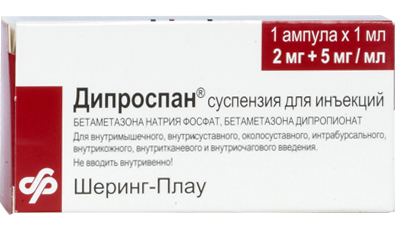
The drugs of the glucocorticoid group include hydrocortisone, diprospan, kenalog, celeston, phlosterone. Injections of these medicines can not affect the restoration of destroyed cartilage or completely normalize the joint. They can only remove inflammation, thereby destroying the focus of the disease. With arthrosis, these medications are necessary to restore normal blood circulation in the joint bag and nutrition of the cartilage. Glucocorticoids are used during a period of severe exacerbation of the disease. During this period, they contribute to the resorption of accumulated fluid in the joint and relieve painful syndrome. After a course of these injections, you can proceed to physiotherapy and manual procedures.
Such drugs are prescribed only if the patient has severe inflammation of the knee joint. 1 injection is always trial. If he begins to act fruitfully, and the disease stops progressing, then the number of injections increases. A similar procedure can be performed no more than 1 time in 10 days. More frequent use of the medication can lead to an imbalance in hormones. Apply hormonal injections more often than normal is harmful. This is an extra trauma to the joint, increasing the likelihood of infection. Cartilage regeneration can be delayed as a result of frequent use of hormonal drugs.
The choice of glucocorticoid for arthrosis: because of the optimal ratio of effectiveness, adverse reactions and cost for the treatment of arthrosis, the most commonly used are Prednisolone (inside or intraarticular) and Methylprednisolone (intravenously, in periarticular tissues or intraarticular). Intramuscular administration is not recommended due to individual differences in absorption by patients in the systemic circulation. It should be remembered that glucocorticoids are used in the minimum effective dosage in order to minimize their number side effects. So, for example, for prednisone, a daily dose of up to 7.5 mg is considered relatively safe.
Plasmolifting in the treatment of arthrosis
This method of treatment was developed relatively recently by Russian researchers. Plasmolifting has become an indispensable drug for the quality treatment of arthrosis. This drug allows you to completely restore the destroyed knee apparatus. This is due to the fact that the drug acts simultaneously on all parts of the musculoskeletal system. Plasma lifting fully restores the joint, normalizes the condition of adjacent muscles, restores destroyed cartilage. The drug can even affect bone tissue.
According to the studies of the developers of this method of treating arthrosis, its use helps to completely get rid of arthrosis at the I and II degrees of development. With grade III arthrosis and in patients with severe concomitant diseases, plasmolifting helps to alleviate or completely eliminate the clinical picture and symptoms. The main plus is that plasmolifting is completely safe for the patient and does not cause any side effects. The main essence of the method is that a person receives part of his own plasma, which is filled with platelets in a laboratory way. The patient donates blood, which is saturated with the necessary elements and injected back into the joint.
The amount of venous blood, which is necessary for 1 injection of such a plasma, is not more than 10-12 ml.
The entire result of the plasmolifting procedure depends on the work of platelets. These elements are used as natural regeneration stimulants in the body. After the course of treatment, the patient observed the formation of new blood vessels, increased blood flow to the affected area, normalization of metabolic processes.
Plasmolifting provokes the natural restoration of the human body. Cartilage begins to recover on its own and the amount of synovial fluid returns to normal.
Other symptoms of arthrosis go away on their own. To relieve pain or swelling, you do not need to use additional medications. Joint performance quickly improves and the patient recovers.
Plasmolifting is used to treat any type of joint, bone and cartilage tissue disorders. If for some methods of treatment it is fundamentally important what lifestyle the patient leads, and a person often has to change it, then with plasmolifting treatment this is not necessary. A similar technique has been used for several years in plastic surgery, dentistry and other areas of medicine. Plasmolifting provokes the restoration of not only internal organs, but also rapid regeneration of the skin. A certain course of injections is enough to completely repair any damaged part of the body.
Hyaluronic Acid Treatment
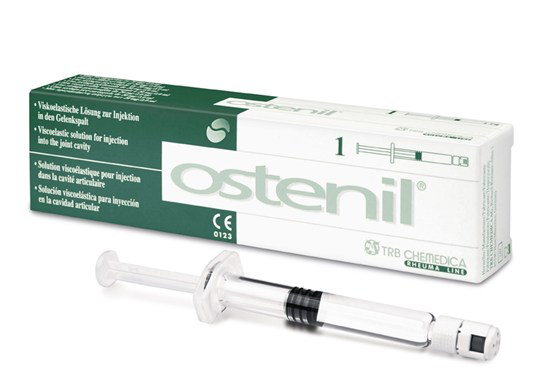
With arthrosis of the knee joint, treatment with hyaluronic acid injections is quite often used. Such procedures help patients with bursitis, gonarthrosis arthritis and arthrosis. After a course of such procedures, a visible effect does appear. This group of medicines includes various drugs: stenil, fermatron, deuralan, crespin gel.
These medicines received the conditional name "liquid prostheses". This is due to the fact that they restore the joint filling its destroyed cavities. In a way, these drugs play the role of synovial fluid, which completely covers the joint, protecting it, nourishes the cartilage, stops the destructive process and provokes tissue regeneration.
Preparations containing hyaluronic acid affect not only the joint, but also cartilage. They contribute to a better glide of its surface, stimulate proper operation and prevent friction. Due to the fact that it is absent, destruction is prevented. At arthrosis of the knee the cartilage dries completely and begins to collapse. Hyaluronic acid penetrates into the cartilage tissue and moistens it, preventing the cartilage from crumbling.
As a result, its stability and elasticity increases. Hyaluronic acid treatment can only be started if all the primary symptoms of the disease have been eliminated. Inflammation should be neutralized with other medicines. When hyaluronic acid enters the focus of inflammation, it loses its healing properties, and therapy does not bring results.
The use of chondroprotectors
The introduction of drugs that are combined in 1 group of chondroprotectors is beneficial for the health of the patient. Such medicines contain special enzymes that positively affect not only the focus of the disease, but also the whole organism. This group includes alflutop, arteparone, contracal.
In recent years, Arthril has become the most popular drug, which has a chondroprotective effect - it is involved in the correction of metabolic disorders that occur in the cartilage of the joint. Its action is based on enhancing the production of proteoglycans by the body as soon as possible after injection, which inhibit the action of chondrolytic enzymes.
Such medications are prescribed exclusively in whole courses and only a doctor can prescribe them. During the 1st stage of treatment, the patient can receive from 3 to 15 injections. The frequency and number of injections depends on the general condition of the patient and on the progression of arthrosis.
Be sure to consult a doctor before treating diseases. This will help to take into account individual tolerance, confirm the diagnosis, verify the correctness of treatment and eliminate negative drug interactions. If you use prescriptions without consulting a doctor, then this is entirely at your own peril and risk. All information on the site is presented for educational purposes and is not a medical aid. All responsibility for the application rests with you.










